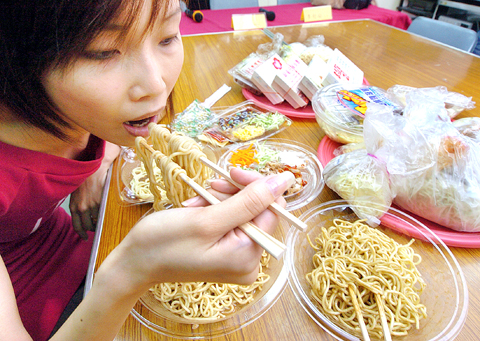Up to 88 percent of cold noodle products tested by the Consumers’ Foundation contained excessive levels of bacteria, secretary-general Wu Jia-cheng (吳家誠) said yesterday.
Sixteen cold noodle samples — four from convenience chain stores and 12 from traditional shops or vendors — were tested in late May, he said.
All 12 samples from traditional stores or vendors had excessive levels of viable bacteria and 11 contained excessive amounts of Escherichia coli (E. coli) bacterium, which is commonly found in soil and in the intestines of humans and animals and causes severe food poisoning.

PHOTO: FANG PIN-CHAO, TAIPEI TIMES
The total viable bacteria counts in two samples each from convenience stores also exceeded permitted levels, Wu said
Factors contributing to the presence of E. coli include cross-contamination between raw and cooked food, as well as poor food handling and storage, Wu said.
Total viable bacteria counts, considered to be the most reliable marker of contamination, are often employed to assess food safety and sanitation during the manufacturing process. High bacteria counts can be attributed to improper cleaning and sanitizing of water, equipment and food materials, Wu said.
He said the sanitary conditions for cold noodle products have deteriorated since the foundation began its annual safety checks on the product two years ago. The foundation urged the Department of Health to demand immediate improvements by imposing stricter penalties for food sanitation violations.
Products that fail safety tests should be removed from store shelves and storeowners should improve their food hygiene standards, the foundation said.
A spokesman for the Hi-Life chain of convenience stores said his company had demanded that the manufacturer of the problem products suspend its supply, adding that it would also launch a comprehensive inspection.
A 7-Eleven store representative questioned the foundation’s methodology, saying that cold noodles generally undergo several rounds of testing during the manufacturing process before stored in refrigerators at 4ºC. The samples that failed to pass the foundation’s test might have been tested under high-temperature conditions, the representative said.
The foundation insists its tests were conducted in accordance with professional standards.

Taiwanese scientists have engineered plants that can capture about 50 percent more carbon dioxide and produce more than twice as many seeds as unmodified plants, a breakthrough they hope could one day help mitigate global warming and grow more food staples such as rice. If applied to major food crops, the new system could cut carbon emissions and raise yields “without additional equipment or labor costs,” Academia Sinica researcher and lead author the study Lu Kuan-jen (呂冠箴) said. Academia Sinica president James Liao (廖俊智) said that as humans emit 9.6 billion tonnes of carbon dioxide compared with the 220 billion tonnes absorbed

The Taipei Mass Rapid Transit (MRT) Wanda-Zhonghe Line is 81.7 percent complete, with public opening targeted for the end of 2027, New Taipei City Mayor Hou You-yi (侯友宜) said today. Surrounding roads are to be open to the public by the end of next year, Hou said during an inspection of construction progress. The 9.5km line, featuring nine underground stations and one depot, is expected to connect Chiang Kai-shek Memorial Hall Station to Chukuang Station in New Taipei City’s Jhonghe District (中和). All 18 tunnels for the line are complete, while the main structures of the stations and depot are mostly finished, he

Taipei is to implement widespread road closures around Taipei 101 on Friday to make way for large crowds during the Double Ten National Day celebration, the Taipei Department of Transportation said. A four-minute fireworks display is to be launched from the skyscraper, along with a performance by 500 drones flying in formation above the nearby Nanshan A21 site, starting at 10pm. Vehicle restrictions would occur in phases, they said. From 5pm to 9pm, inner lanes of Songshou Road between Taipei City Hall and Taipei 101 are to be closed, with only the outer lanes remaining open. Between 9pm and 9:40pm, the section is

China’s plan to deploy a new hypersonic ballistic missile at a Chinese People’s Liberation Army Rocket Force (PLARF) base near Taiwan likely targets US airbases and ships in the western Pacific, but it would also present new threats to Taiwan, defense experts said. The New York Times — citing a US Department of Defense report from last year on China’s military power — on Monday reported in an article titled “The missiles threatening Taiwan” that China has stockpiled 3,500 missiles, 1.5 times more than four years earlier. Although it is unclear how many of those missiles were targeting Taiwan, the newspaper reported